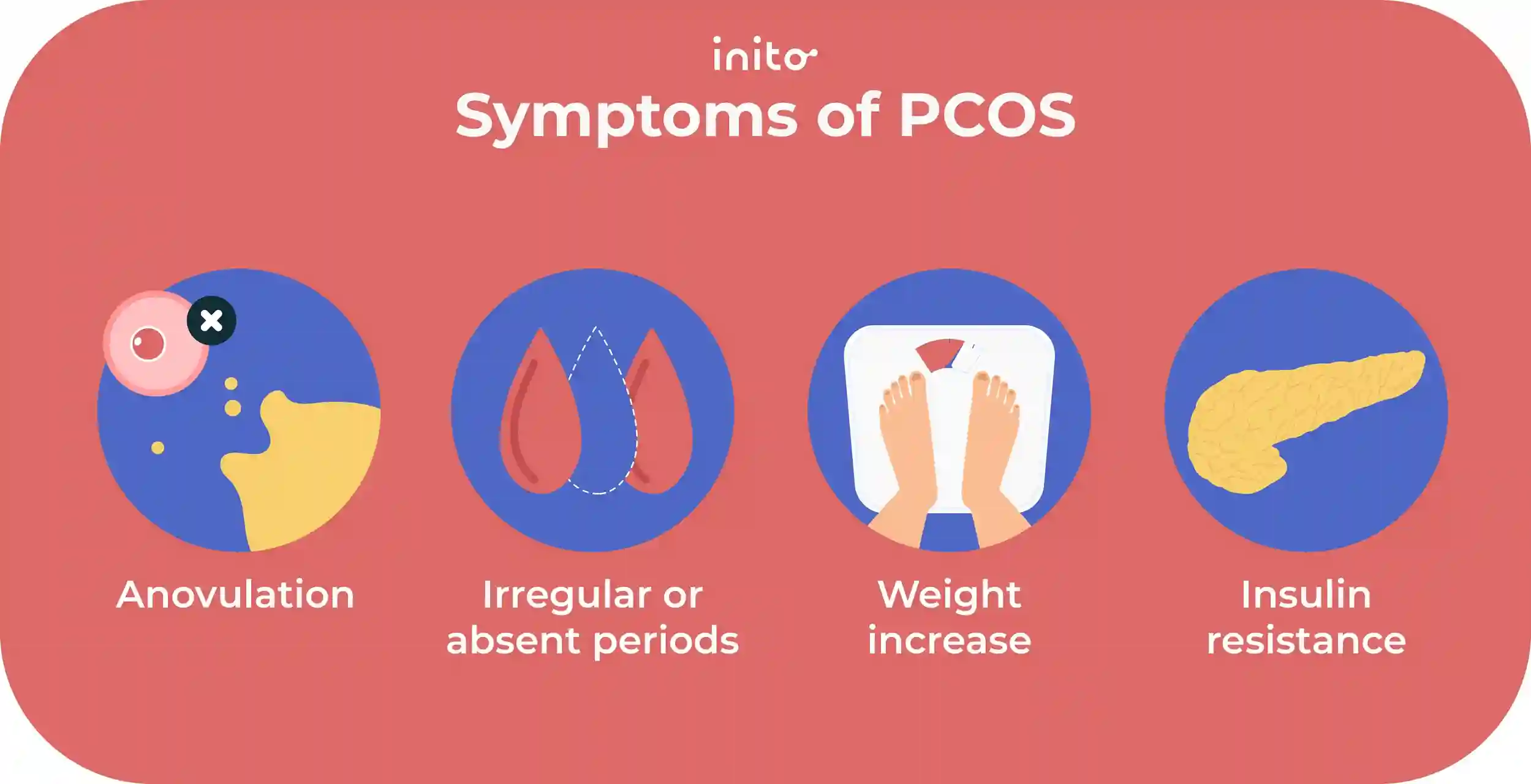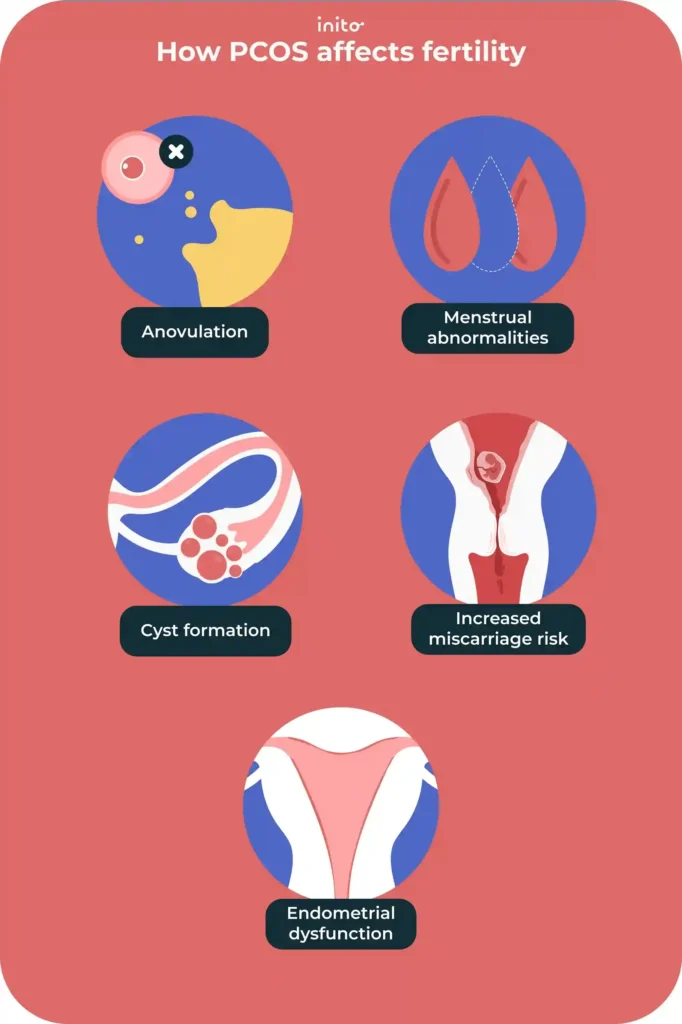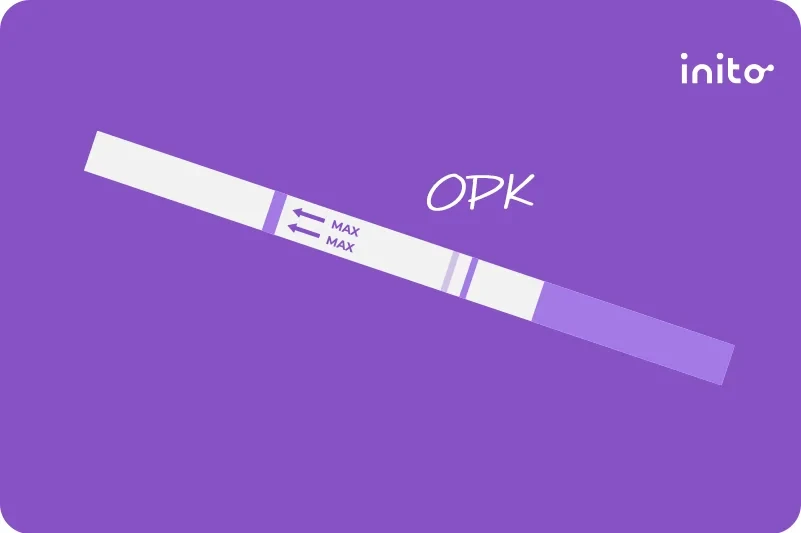Content table
The fertility journey can be a challenging one.
This is especially true if you’re navigating endometriosis or polycystic ovary syndrome (PCOS). Both can wreak havoc on your period and your hormones. And this may mean additional struggles with getting pregnant.
If this sounds familiar, know you’re not alone. Endometriosis occurs in 1 in 10 women while PCOS affects 1 in 5 women of childbearing age.
But the silver lining is that it’s still possible to get pregnant! Let’s take a deeper look at endometriosis and PCOS. This will help you learn more about them and what they mean for your fertility.
What is endometriosis?

Imagine taking your normal menstrual cycle pain and increasing it. A lot. That gives you an idea of what endometriosis feels like.
But what’s going on inside your body with endometriosis?
Endometrial tissue (which is normally found inside the uterus) grows outside of the uterus. These growths usually show up in the fallopian tubes or ovaries. But they can also make their way to other parts of the body. The exact cause of endometriosis is not known, but it is linked to excess estrogen.
A cycle for someone without endometriosis looks like normal shedding of the uterine tissue – it leaves through the vagina as your period.
But for those with endometriosis? Your uterus can still shed its lining during your period, but the excess tissue stays trapped.

And this can lead to undesirable symptoms such as:
- Painful cramps during your menstrual cycle and ovulation
- Heavy or irregular menstrual cycles
- Bleeding between periods
- Painful sex
- Pelvic pain
- Digestive issues
- Weight fluctuations
How to diagnose and treat endometriosis?

Imaging methods like ultrasound (USG), MRI, and laparoscopy give your doctors a look at what’s going on and help them diagnose endometriosis.
What is PCOS?

Polycystic ovary syndrome (PCOS) is a condition that can mess with your hormones. It causes your body to increase the production of male hormones (androgens). This leads to tiny cysts forming on your ovaries. And these cysts can make your ovaries larger and disrupt ovulation.

Here are some other common PCOS symptoms:
- Anovulation
- Irregular or absent periods
- Weight increase
- Insulin resistance
- Excessive unwanted hair growth
- Acne
These symptoms may help doctors diagnose this condition, but it can be tricky.
How to diagnose and treat PCOS?

PCOS can be diagnosed using the Rotterdam criteria. This means two of the following three things must be true:
- Oligo-anovulation (irregular or infrequent periods)
- Hyperandrogenism (which manifests as symptoms like excessive unwanted hair growth and acne)
- Polycystic ovaries (ultrasound shows more than 12 follicles that are 2-9 mm in diameter and/or at least one ovary having an ovarian volume of over 10 mL)
While there is no cure for PCOS, it can be easily managed. One of those ways is via lifestyle changes.
Regular exercise and healthy eating are key to maintaining a healthy weight. And they make your hormones happy, too! These two things together may give you more regular periods and ovulation – yay!
Read more: Get Pregnant with PCOS: Your Complete Guide
Medication is another option for someone with PCOS. Anti-androgen meds can help with unwanted hair and acne. And other medications help your body deal with insulin resistance.
Some doctors recommend hormonal birth control to help regulate periods. But if you want to get pregnant, hormonal birth control isn’t for you. Healthcare professionals may also opt to prescribe meds for inducing ovulation, such as clomiphene or letrozole.
Read more: Clomid® vs. Letrozole: A Complete Comparison
The goal of treating PCOS? To regulate ovulation you can increase your chances of getting pregnant.
How do I know if I have PCOS or endometriosis?
|
Endometriosis |
PCOS |
|
|
What happens |
Endometrial tissue grows outside the uterus |
Multiple cysts form in the ovaries |
|
Main hormonal imbalance |
High estrogen levels |
High androgen and LH levels |
|
Organs affected |
Fallopian tubes, ovaries, pelvic lining, bladder, rectum, etc. |
Ovaries (primarily) |
|
Predominant symptoms |
|
|
|
Diagnosis |
Symptoms, USG, laparoscopy |
Symptoms, USG, blood androgen levels |
|
Treatment goal |
Balance estrogen and reduce inflammation |
Regulate ovulation and reduce high androgen levels |
If you were wondering, “What’s more painful endometriosis or PCOS?” Usually, it’s endometriosis. The painful periods this condition is known for can be debilitating. We are talking about pain that’s so severe that you can’t function or perform your daily activities.
However, that doesn’t mean the experience will be the same for everyone with this condition. And there may be some women as well who experience pain with PCOS.

The TLDR of it all? Symptoms of PCOS and endometriosis can overlap. This makes it confusing to know which one you have.
Can endometriosis be misdiagnosed as PCOS? Well, because both are diagnosed using scans, there isn’t much room for error. The scan typically tells all.
Generally speaking, PCOS = irregular cycles while endo = painful cycles. But this is not always the case. The way to know for sure? Consult a doctor.
Can endometriosis and PCOS impact fertility and TTC?
Yes – both PCOS and endometriosis make it more difficult to get pregnant. But not impossible!
This may lead you to the question: “Which is worse for fertility, PCOS or endometriosis?” The answer? You can’t really compare the two. They are different conditions that depend on unique factors like:
- Symptoms
- Treatment
- Lifestyle
- Fertility goals
Both PCOS and endometriosis present challenges that can make your TTC journey harder, but not impossible. Both conditions can be managed to help increase your chances of pregnancy.
Let’s take a deeper look.
Endometriosis’ impact on fertility

Having endometriosis can make getting pregnant more challenging. But there are strategies and treatments available to make pregnancy an option.
Let’s see how endometriosis can affect your fertility.
- Abnormalities in ovulation. Endometriosis can cause period irregularities and make it harder to predict your ovulation and your fertile window. Studies show that this condition can also affect your egg quality.
- Fallopian tube occlusion. Endometriosis can create scar tissue that blocks your fallopian tubes. This keeps the sperm and egg from meeting, which means fertilization doesn’t happen.
- Implantation issues. Endometriosis can create an environment that’s both inflamed and estrogen-dominant. This makes implantation more difficult.
- Birth control struggle. Birth control is usually prescribed to help with endometrial pain. But birth control also prevents ovulation, which is counterintuitive for getting pregnant.
This all sounds daunting, but don’t lose hope! Getting pregnant with endometriosis is possible. It just means you’ll need more planning and support.
There are some great options out there including:
- Pain and hormonal medications
- Intrauterine insemination (IUI)
- Egg freezing
- In vitro fertilization (IVF)
Read more: Your Guide to Getting Pregnant With Endometriosis
Now let’s look at PCOS and fertility.
PCOS’ impact on fertility

Don’t let PCOS ruin your dreams of getting pregnant. This condition can make things more difficult, but you can navigate it.
Here’s how PCOS can affect your fertility.
- Anovulation or oligo-ovulation. This is the number one cause of infertility. This means that your ovaries might not release an egg every month. Due to high androgen levels in PCOS, your ovarian follicles don’t mature and release eggs as they normally should.
If you have 1-2 anovulatory cycles per year, that’s nothing to worry about. But if this happens more and more often, that’s cause for concern.
So how do you know if you’re ovulating or not?
This is where Inito can help. The Inito fertility monitor tracks all four fertility hormones which include LH, estrogen, PdG (a urine metabolite of progesterone), and FSH on a single test strip. Each has its own unique role in getting pregnant. LH, estrogen, and FSH help track your fertile window and predict ovulation. And PdG helps confirm ovulation. This is key to fertility!
- Menstrual abnormalities. Irregular ovulation means your period is irregular. This makes it tricky to predict your fertile window and time sex. Additionally, without ovulation, there’s no egg for the sperm to fertilize.
- Cyst formation. In rare cases, big cysts can cause blockages in the fallopian tubes. This makes it harder for the sperm and egg to meet and for fertilization to happen.
- Miscarriage risk. Studies show that PCOS may be linked to an increased risk of miscarriage.
- Endometrial issues. PCOS can make the lining of your uterus a less-than-ideal place for implantation. This is called endometrial dysfunction. Normally, ovulation triggers progesterone production. This helps prep the uterine lining for pregnancy. But with PCOS, ovulation is irregular. Meaning your body may have too much estrogen and not enough progesterone. This can make pregnancy harder and increase miscarriage risk factors.
Here are some things you can do to increase your chances of getting pregnant with PCOS:
- Losing weight (if you’re overweight or obese)
- Eating healthy
- Regular exercise
- Medication for treating hyperthyroidism and insulin resistance
- Fertility treatments such as ovulation induction, IVF, and IUI
Read more: Get Pregnant with PCOS: Your Complete Guide
Fertility challenges don’t have to be a roadblock. In many cases, all it takes is a shift in your lifestyle. Diet and exercise can have a huge impact on your ability to manage PCOS.
However, for advanced cases, a fertility specialist can help create a plan to increase your chances of pregnancy.
Speaking of pregnancy …
Let’s take a look at some things to consider for pregnancy with PCOS and endometriosis.
Can endometriosis and PCOS impact pregnancy?
Some women may experience additional challenges to their pregnancy with endometriosis or PCOS. But this isn’t the case for everyone.
Here are some potential impacts to be aware of.
Endometriosis’ impact on pregnancy
Studies show endometriosis increases the risk of preterm birth (before 37 weeks) by 50%. This means you’ve got to be aware of symptoms that look and feel like labor throughout your pregnancy.
Endometriosis also puts you at risk of placenta previa. It’s a serious complication where the placenta implants too close to the cervix. If you experience bright red vaginal bleeding during pregnancy, call your doctor immediately.
PCOS’ impact on pregnancy
PCOS is associated with insulin resistance. This can raise your chances of diabetes and high blood pressure during pregnancy.
And like endometriosis, PCOS also puts you at a higher risk of preterm birth.
These things may sound scary. But they’re a reminder to monitor your pregnancy. And always talk to your doctor about any questions or concerns. Remember – many women with PCOS and endometriosis have healthy pregnancies!
Now we know that PCOS and endometriosis have some similarities. So have scientists found a link between the two?
Is there a connection between endometriosis and PCOS?

It’s not totally clear if PCOS and endometriosis are directly linked. They are both hormonal issues that affect female fertility. But, they work in nearly opposite ways. Their connection is more of an indirect one, and studies show this.
One study found that women with PCOS had a higher chance of also having endometriosis (36.4% vs. 4.4%). This suggests the two may share some underlying risk factors, including endocrinopathy.
Another study shows PCOS and endometriosis on opposite ends of the hormone spectrum. PCOS can cause irregular ovulation and excess of male hormones (androgens). And endometriosis can lead to an excess of female hormones (estrogen).
In short? More research is needed to better understand the link between PCOS and endometriosis.
Can you have both endometriosis and PCOS?
It’s rare, but it is possible to have both. Studies show that about 7-8% of women with PCOS also have endometriosis.
As you can see from this article, both conditions are related to hormones. And they may have something to do with genetics, too. They both lead to period irregularities and problems with TTC and pregnancy. But the exact causes of PCOS and endometriosis? They remain a mystery.
Treating either or both starts with regulating your hormones and managing your symptoms. Then, you and your doctor can create a personalized treatment plan.
In review
- Endometriosis is a condition where the inner uterine lining grows outside the uterus. It can cause chronic pelvic pain, irregular bleeding, and fertility issues.
- Polycystic ovary syndrome (PCOS) is when multiple cysts form on the ovaries due to excess male hormones (androgens). This hormonal imbalance leads to ovulatory issues, irregular menstrual cycles, weight gain, excessive hair growth, and trouble conceiving.
- Both endometriosis and PCOS can be diagnosed by imaging.
- The treatment goal of endometriosis is to manage pain and reduce inflammation. This is done through medications or surgery.
- With PCOS, the goal is to regulate ovulation and manage symptoms. This can happen via lifestyle changes and/or medication.
- Endometriosis and PCOS can both increase the risk of pre-term birth.
- PCOS may increase the risk factors of gestational diabetes and high blood pressure.
- Both PCOS and endometriosis can make it more difficult to get pregnant. But not impossible! Fertility treatment options like ovulation induction, IUI, or IVF can increase your chances.
Was this article helpful?
- Polycystic Ovarian Syndrome and Endometriosis as Two Evil Extremes of Health Continuum | NIH
- All Women With PCOS Should Be Treated For Insulin Resistance | NIH
- Get Pregnant with PCOS: Your Complete Guide
- Implantation Failure in Endometriosis Patients: Etiopathogenesis | NIH
- Your Guide to Getting Pregnant With Endometriosis | Inito
- Polycystic ovarian syndrome and miscarriage in IVF: systematic revision of the literature and meta-analysis | Springer Link
- Endometrium in PCOS: Implantation and predisposition to endocrine CA | NIH
- PCOS And Pregnancy: All You Need To Know | Inito
- Primiparous singleton women with endometriosis have an increased risk of preterm birth: Meta-analyses | NIH
- The association of endometriosis with placenta previa and postpartum hemorrhage: a systematic review and meta-analysis | NIH
- Treatment Polycystic ovary syndrome | NHS
- Does PCOS affect pregnancy? | NIH
- Is There A Relationship between Polycystic Ovary Syndrome and Endometriosis? | ScienceDirect
- The Potential Implications of a PCOS Diagnosis on a Woman’s Long-Term Health Using Data Linkage | Oxford Academic
- Endometriosis and polycystic ovary syndrome are diametric disorders | NIH
- Examining the co-occurrence of endometriosis and polycystic ovarian syndrome | ScienceDirect












